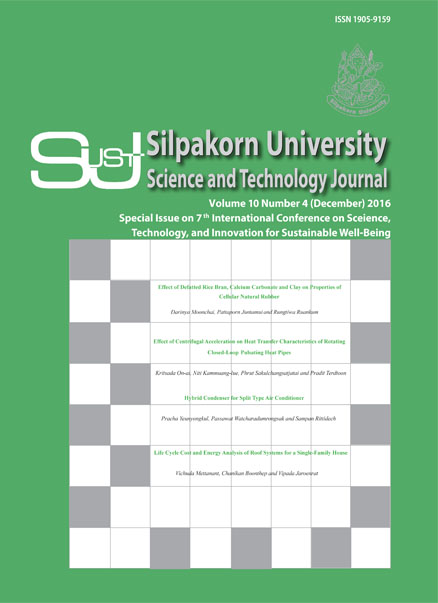Life Cycle Cost and Energy Analysis of Roof Systems for a Single-Family House
Main Article Content
Abstract
In this study, the life cycle cost (LCC) and energy consumption of a residential home were evaluated to find the lowest LCC among 12 roof systems. EnergyPlus 8.3 program was employed to estimate the annual cooling requirements of a two-storey house with total area of 240m2. The analysis was carried out for four types of roof insulation (aluminum foil, fiberglass, polystyrene and polyurethane)and three types of roof tires (concrete, ceramic and fiber cement).The concrete roof tiles without insulation were set as the baseline case. Results show the concrete roof tiles with fiberglass insulation provide the highest energy saving in the air conditioning system at 10.98%. However, the roof using fiber cement roof tiles with polystyrene insulation was found to be the most cost effective roof system. It shows the lowest LCC with the reduction in LCC by 3.31%.
Downloads
Article Details
References
Al-Sallal, K. A. (2003). Comparison between polystyrene and fiberglass roof insulation in warm and cold climates. Renewable Energy, 28(4): 603-611.
ASHRAE (2001). ASHRAE Handbook Fundamentals, American Society of Heating, Refrigerating and Air-Conditioning Engineers, Inc., Atlanta.
ASHRAE. (2005). ASHRAE Handbook Fundamentals, American Society of Heating, Refrigerating and Air-Conditioning Engineers, Inc., Atlanta.
Boonyatikarn, S., and Chindavanig, T. (1993) An Evaluation of Thermal Comfort and Related Variables in Thai Architecture, Bangkok: Chulalonkorn University Press.
Bribián, I. Z., Capilla, A. V., and Usón, A. A. (2011). Life cycle assessment of building materials: Comparative analysis of energy and environmental impacts and evaluation of the eco-efficiency improvement potential.Building and Environment, 46(5): 1133-1140.
Crawley, D. B., Lawrie, L. K., Winkelmann, F. C., Buhl, W. F., Huang, Y. J., Pedersen, C. O., Strand, R. K., Liesen, R. J., Fisher, D. E., Witte, M. J., and Glazer, J. (2001). EnergyPlus: creating a new-generation building energy simulation program. Energy and Buildings, 33(4): 319-331.
KMUTT (1998). Construction Material Manual, Bangkok: King Mongkut’s University of Technology Thonburi.
Thai Meteorological Department (2015). The Climate of Thailand.[Online URL: www.tmd.go.th/] accessed on January 10, 2015.
The Department of Public Works and Town & Country Planning of Thailand (2015). House Plans for Citizens. [Online URL:www.dpt.go.th] accessed on January 12, 2015.
The Metropolitan Electricity Authority of Thailand (2015). Electricity tariffs. [Online URL:www.mea.or.th/] accessed on January 12, 2015.
U.S.Department of Energy (2015). Weather Data.[Online URL:apps1.eere.energy.gov/buildings/energyplus] accessed on January 10, 2015.


